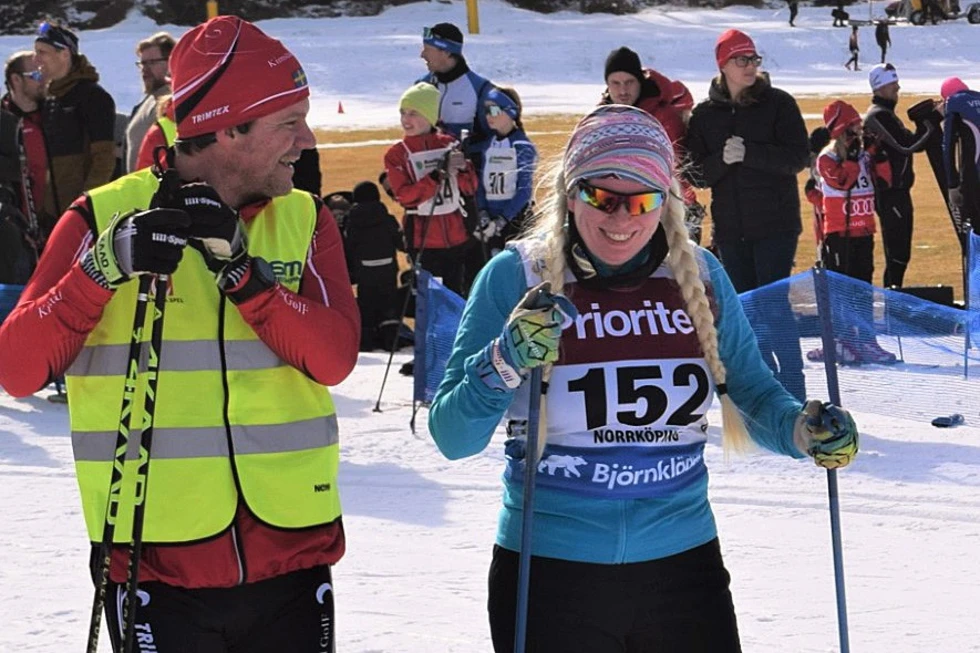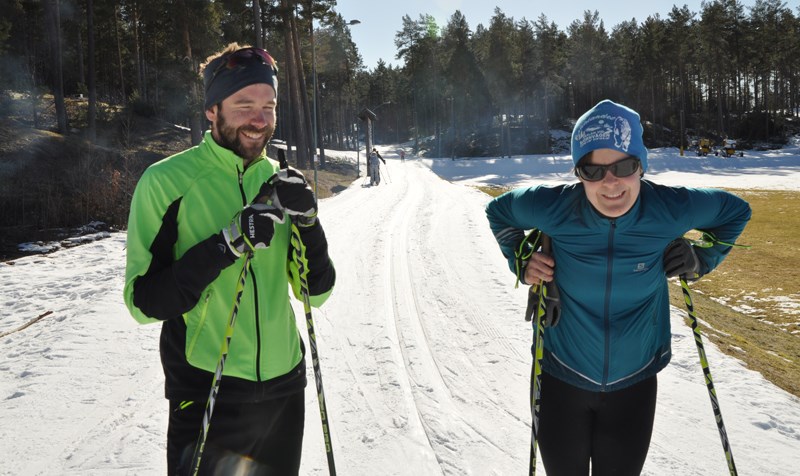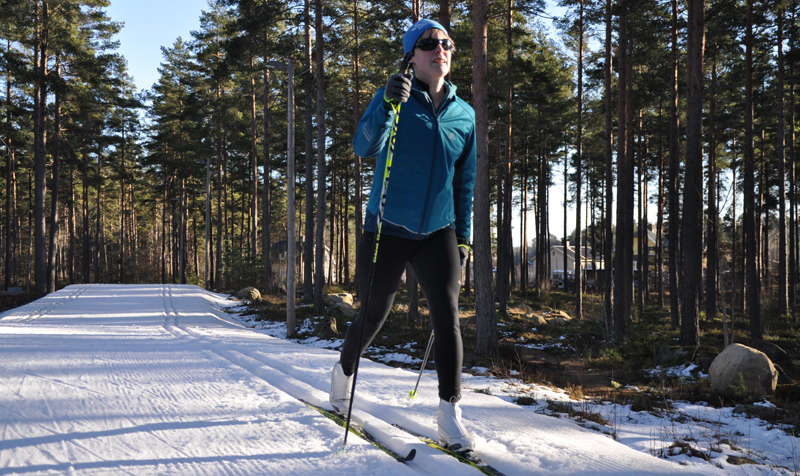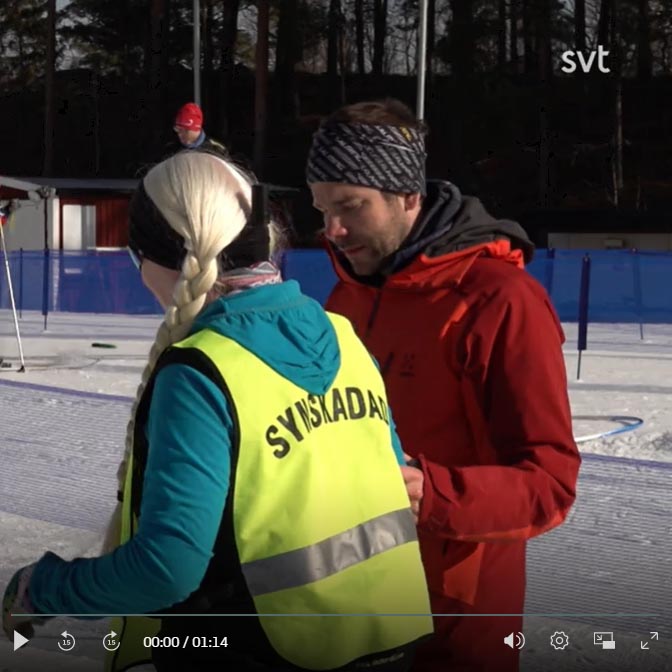Kimstad ski race
Cross-country skiing with digital guidance
12 March 2022
Links to more articles (SWE)
SVT - Swedish Television
New programme helps visually impaired skiers to get ahead
At the Kimstad ski race, a new GPS program was debuted to help visually impaired people ski. Skiers can program a route themselves, receiving alerts about hills, turns and where they are in the ski trail.
– It worked just the way they wanted it to work, says Ida Östlund.
A total of five skiers tested the new program.
The programme runs through the phone and a pair of headphones to a GPS unit connected to the ski route. When you’re on the right side of the track, the headphones tick in both ears; if you’re too far to the left, it only ticks in the left ear. Then the skier gets a notification to move more to the right until it ticks in both ears again. The further away from the track you get, the louder the ticking sound.
It is also possible for the rider to program alerts for when to turn or when there is a hill. Olle Axelsson is the person behind the programme and he has had the idea for a long time.
– A friend and I talked about five years ago that there should be help for the visually impaired to play sports, he says.
Got the idea five years ago
Olle Axelsson helped the skaters get started with the programme and then they set off on the track. In total, five skiers tested the programme, and today they had an official behind them in the ski slope for safety reasons, but in the future they will be able to ski completely on their own. Ida Andrae was one of the skiers.
– It feels much easier to keep track of the track, where it turns and where there are slopes,” she says.
Corren
A Linköping invention tested in the ski tracks

Anne-Lie Telning was one of the participants who got to test the new system.
On Saturday, Kimstad GoIF organised a district ski competition. This year’s big news was that the skiers were offered a virtual escort on the spot. “An incredible feeling of freedom”, says Anne-Lie Telning after testing.
There was great skiing and sunshine at Kimstad’s ski centre. But the big news would turn out to be a technical invention. Olle Axelsson from Linköping has developed a virtual companion.
– It’s a system for visually impaired skiers that means they don’t have to rely on a physical guide. The system has three components. A pair of Bluetooth headphones, a device attached to a headband that sends commands to the headphones and then the person’s phone. These help the person navigate the ride. If the rider is on the right track, a ticking sound is heard, but if the rider is off track, the sound is adjusted between the right and left ear. All this is personal, so each skier can decide how the sound changes, says developer Olle Axelsson.
The system also includes a kind of live voice that warns of different events in the track.
– This works like a live coach. The voice can warn that a hill is coming in ten metres, that there are ten metres left of the hill or that the hill is finished.
There is also the possibility to further develop the system.
He sees the system’s use in both training and racing contexts.
– At the moment, I think it will be used mainly in organised training and exercise activities for people with visual impairments. But in the future, it may become a standard feature at Paralympics and other major competitions, Olle says.
Prior to the competition, Kimstad GoIF ski section leader Björn Westerström was looking forward to implementing the system.
– If everything goes well, we see a great benefit in being able to use this during training activities, he says.
Five visually impaired skiers had the chance to test the system on Saturday. Anne-Lie Telning was one of them.
– It worked really well and the skiing felt very safe all the way. For me, this was almost like a cow race because it was the first time this season that I was on skis, thanks to the technology. To be able to ski by myself without a guide was an incredible feeling of freedom,” she says.
Skidor.com
Virtual guidance - now a reality
For several years now, there has been talk of virtual escorting, whereby a visually impaired person can be escorted without the help of a personal escort. Now it’s possible!

Olle Axelsson and Ida Östlund catch up in the sun as they test the ski trails in the days before the virtual guided skiing premiere. Ida, who is blind, is skiing the track all by herself with the help of the virtual guide, a system developed by Olle.

With the help of technology, we can develop and enrich our lives and, not least, make opportunities available to more people. But it often takes a long time to move from vision to reality, as has been the case with virtual escorting, where the possibility has long been discussed and facilities prepared for future technological developments. Now the technical solutions are starting to fall into place and the world premiere has now been for people with visual impairments who have competed for the first time on skis with virtual guidance.
This particular solution is based on an extremely high-precision GPS device. The ski track is first learned by recording a lap as a reference and the skier then receives feedback via bluetooth headphones. As soon as the skier goes off the reference track, information is given on whether you are slightly to the left or to the right. Warnings about bends, downhills and track drops can also be entered, or any information the user wants and needs.
Olle Axelsson, who developed the system, explains that it works just as well for classic skiing as for skating, you just have to adapt the type of guidance to your skiing style.
– It’s an amazing freedom to be able to ski by yourself without having to be so dependent on another person skating next to you,” says Ida Östlund, who has been involved in providing feedback from real-life use in ski tracks and on the running track. In particular, the precise guidance opens up possibilities for more independent training in different sports and also for outdoor guidance in everyday life.
– I think this is an aid that can help people with visual impairment, who are currently afraid to go outside, to really get out and feel safe,” says Ida. Having a virtual escort for people with visual impairments in activities such as skiing, roller skiing and running, but also in everyday life, is obviously a wish for the future.
The system is now ready for use in both training and competition. In the first competition, five people with full or partial sight loss participated in an open class in the Kimstadloppet, Norrköping. Mixed with other adults and children in the open class, they skied any race distance, which for the participants was 5 km and 8.5 km respectively. The style was optional, classic technique or skate.
The pioneers in the first competition were Ida Östlund (Stockholm), Håkan Axelsson (Borås), Ida Andrae (Norrköping), Johan Pettersson (Linköping) and Anne-Lie Telning (Stockholm). Considering all the children in the track and the premiere competition, an official accompanied each skier on skis with a virtual escort, but no guidance in the track was needed.
– It’s a revolution! Says Håkan Axelsson happily in an interview after the finish. Håkan, who arrived from Borås on the morning of the race, spent half an hour skating around the tracks as an exercise in the system before the start. “It’s clear that it will go even better when you get to practice and get used to the guidance even more, but that it works so well with so little practice is incredibly good!
Anne-Lie Telning, who heard about the competition just days before and immediately got on the phone to sign up, had a similarly short test period. But the fact that it was a new way of being led along the ski track was not apparent to Anne-Lie, who literally flew along the track. When asked by the organiser if they wouldn’t join as a team in a 6-hour race the following week, Anne-Lie is fired up, before remembering that she was booked up the day of the race. But maybe next year?
Johan Pettersson spent the longest time on the track, but was probably also the most satisfied at the finish. 8.5 km completed on his own as he skis again for the first time in 15 years!
– Next time I’ll have to wear thinner clothes, Johan says after sweating profusely in the thick cover jacket under the blazing sun and clear blue sky.
Ida Andrae, who lives just 5 kilometres from the ski centre, was looking forward to being able to go skiing on her own in the future without the help of friends. – It will be perfect, just take the shuttle to the ski centre, put on the skis, go and then come back by shuttle!
Everyone on snow, and more and better – these are some of the keywords of the Swedish Ski Association that go hand in hand with the development of virtual escorting.
A prerequisite for offering training for all, is to have access to various aids at the facilities. It should be as natural to have different versions of sit-skis, virtual guidance, as it is to have loan skis for children and rental skis for adults. With small steps, we are hopefully
If you have any questions about virtual escorts, participation in the competition and try-outs, other assistive devices or other facility issues, please contact facility consultant Jonas Braam at +46 (0)733-223222 or Jonas.Braam@skidor.com

